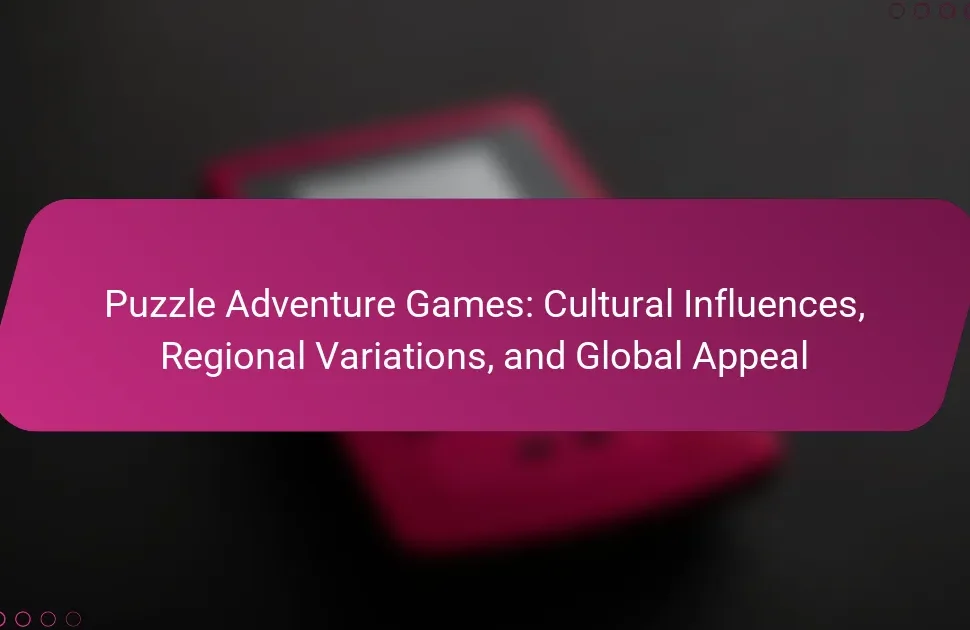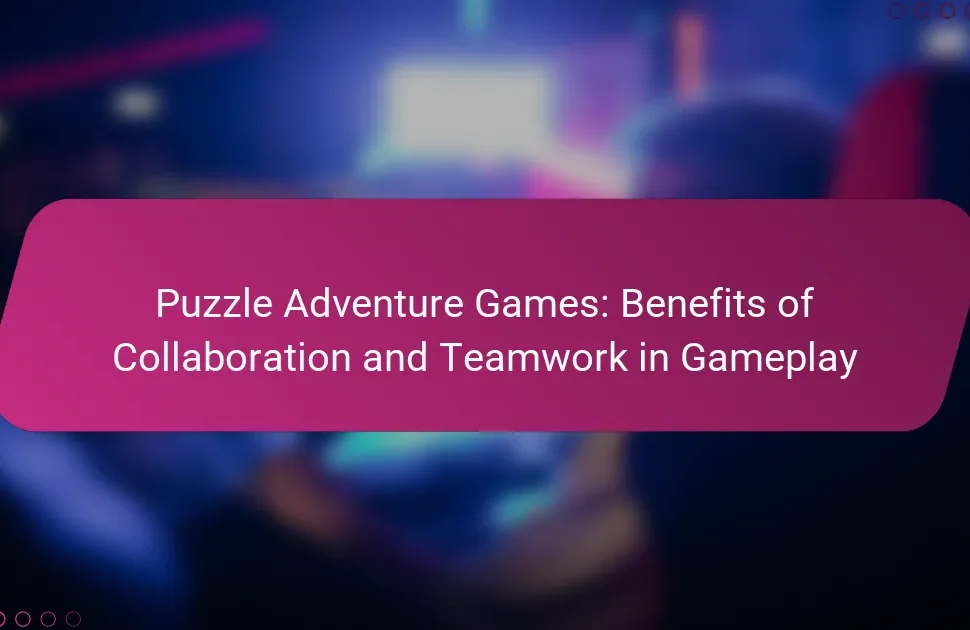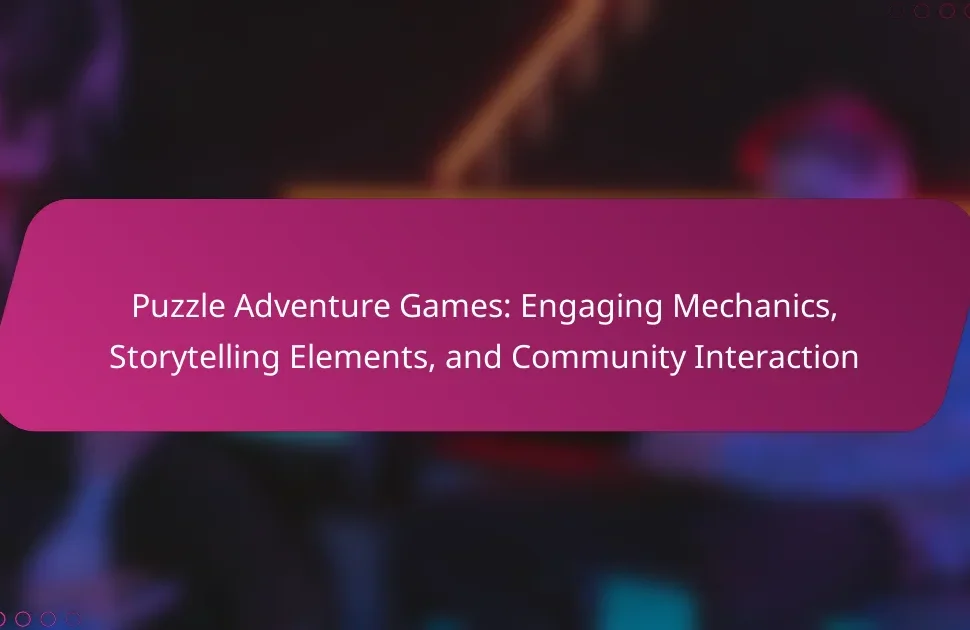Puzzle adventure games offer players a unique blend of narrative exploration and challenging puzzles that test critical thinking skills. This article explores the distinct challenges players face, the various types of puzzles encountered, and effective strategies for overcoming obstacles. Notable games like “Mystic Realms” and “Echoes of the Past” exemplify these engaging elements, enriching the overall gaming experience. Understanding these aspects can enhance player satisfaction and retention in this immersive genre.
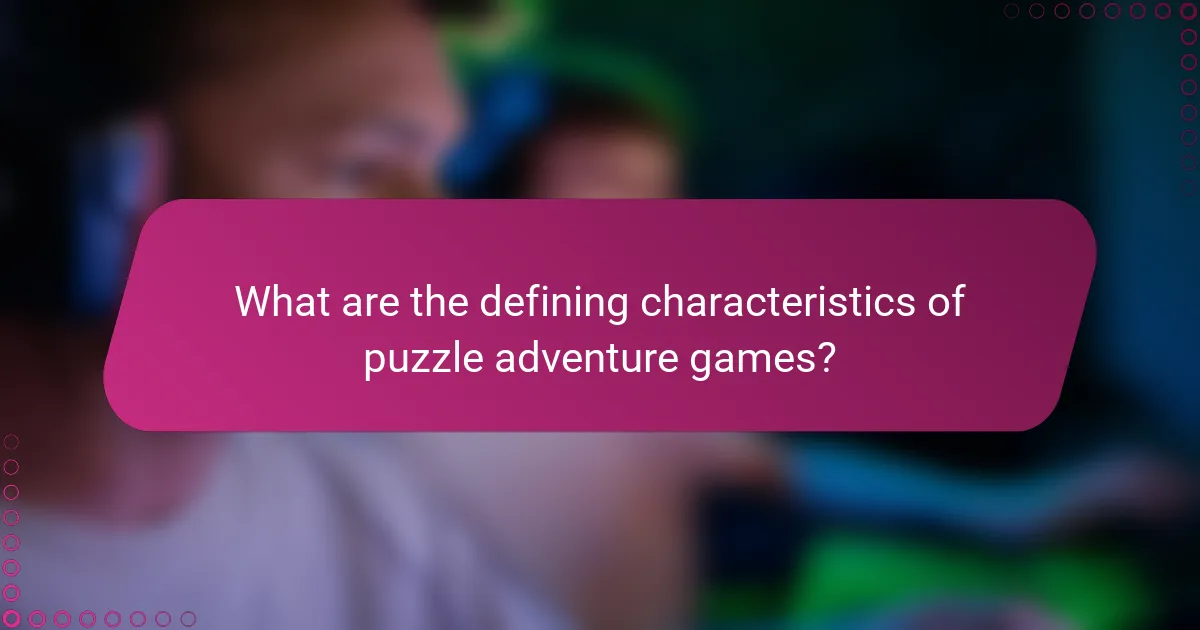
What are the defining characteristics of puzzle adventure games?
Puzzle adventure games are defined by their combination of narrative-driven exploration, challenging puzzles, and immersive environments. Players engage with unique challenges that often require critical thinking and problem-solving skills. Common puzzle types include logic puzzles, environmental puzzles, and inventory-based challenges. Strategies vary, with players often needing to combine items, decipher clues, and explore thoroughly to progress. These games emphasize creativity and critical thinking, making them appealing to a diverse audience.
How do narrative elements enhance gameplay experience?
Narrative elements significantly enhance gameplay experience by providing context and emotional depth. They engage players, making challenges more meaningful and immersive. A well-crafted story motivates players to solve puzzles, as they feel connected to the characters and plot. For example, a backstory can explain a puzzle’s significance, adding layers to the gameplay. This connection transforms simple tasks into compelling quests, increasing player satisfaction and retention.
Which game mechanics are commonly utilized in puzzle adventure games?
Puzzle adventure games commonly utilize mechanics such as item collection, environmental puzzles, and narrative-driven choices. These mechanics challenge players to think critically and creatively.
Item collection often involves gathering objects that unlock new areas or solve puzzles. Environmental puzzles require players to interact with their surroundings, manipulating objects or elements to progress. Narrative-driven choices impact the storyline, allowing players to shape their adventure based on decisions made throughout the game.
Additionally, time-based challenges and cooperative gameplay can enhance the experience, adding layers of complexity and requiring teamwork. These mechanics create a rich tapestry of challenges that engage players deeply in the game world.
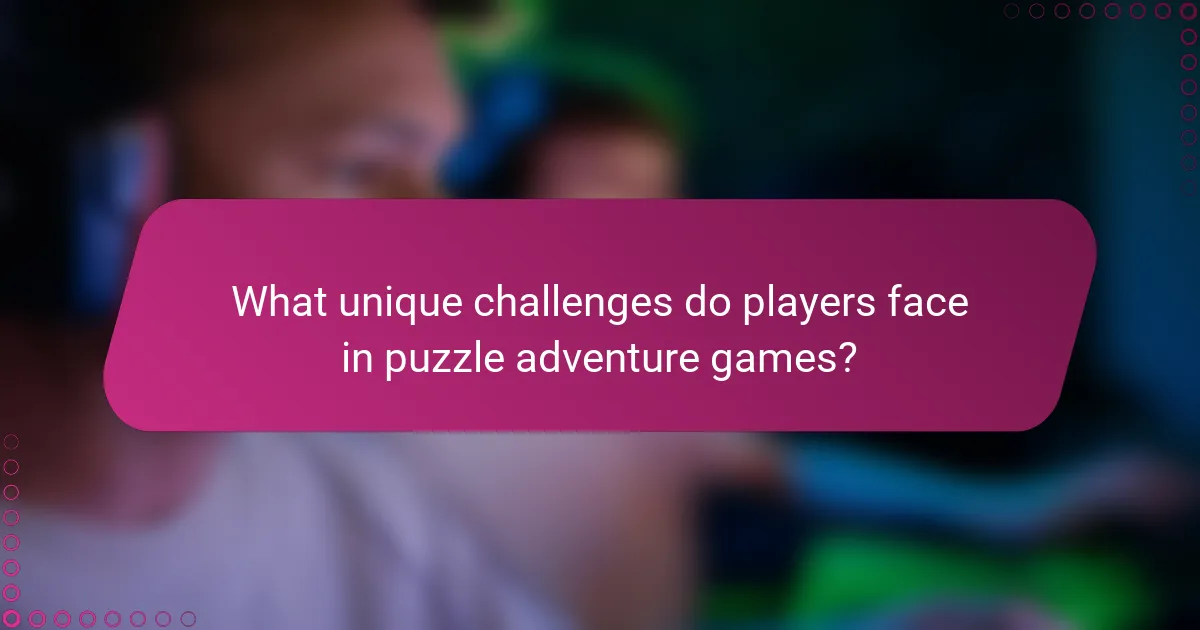
What unique challenges do players face in puzzle adventure games?
Players in puzzle adventure games face unique challenges, including complex problem-solving, time constraints, and environmental puzzles. These challenges require strategic thinking and adaptability.
Complex problem-solving involves deciphering clues and making connections between various elements within the game. Players often encounter intricate puzzles that demand logical reasoning and creativity, enhancing the gameplay experience.
Time constraints can add pressure, forcing players to think quickly and make decisions under stress. This urgency can lead to mistakes but also heightens the thrill of overcoming obstacles.
Environmental puzzles present another challenge, requiring players to interact with their surroundings in innovative ways. These puzzles often involve manipulating objects or navigating through multi-layered environments, testing players’ spatial awareness and observational skills.
Overall, these unique challenges contribute to the depth and engagement of puzzle adventure games, encouraging players to develop effective strategies for success.
How do time constraints affect puzzle-solving strategies?
Time constraints can significantly influence puzzle-solving strategies in puzzle adventure games. Players often adopt quicker, more heuristic approaches under pressure, prioritizing speed over thoroughness.
Time limits may lead to increased reliance on pattern recognition and trial-and-error methods. Players might skip careful analysis of clues, opting instead for immediate solutions. As a result, the quality of problem-solving can vary, with some players thriving under pressure while others may struggle.
Additionally, time constraints can affect player enjoyment and engagement. Rushed gameplay may diminish the immersive experience that puzzle adventure games typically offer. Balancing challenge and time pressure is crucial for maintaining player satisfaction.
Ultimately, understanding the impact of time constraints can help game designers create more engaging and balanced experiences that cater to diverse player strategies and preferences.
What role does exploration play in overcoming challenges?
Exploration plays a crucial role in overcoming challenges in puzzle adventure games by encouraging creative problem-solving. Players engage with diverse puzzle types, enhancing their cognitive skills and adaptability. This process fosters resilience as players learn to navigate obstacles and devise strategies. Unique challenges within these games often require players to explore different environments, leading to varied solutions and deeper engagement. As a result, exploration not only drives gameplay but also cultivates critical thinking and perseverance.
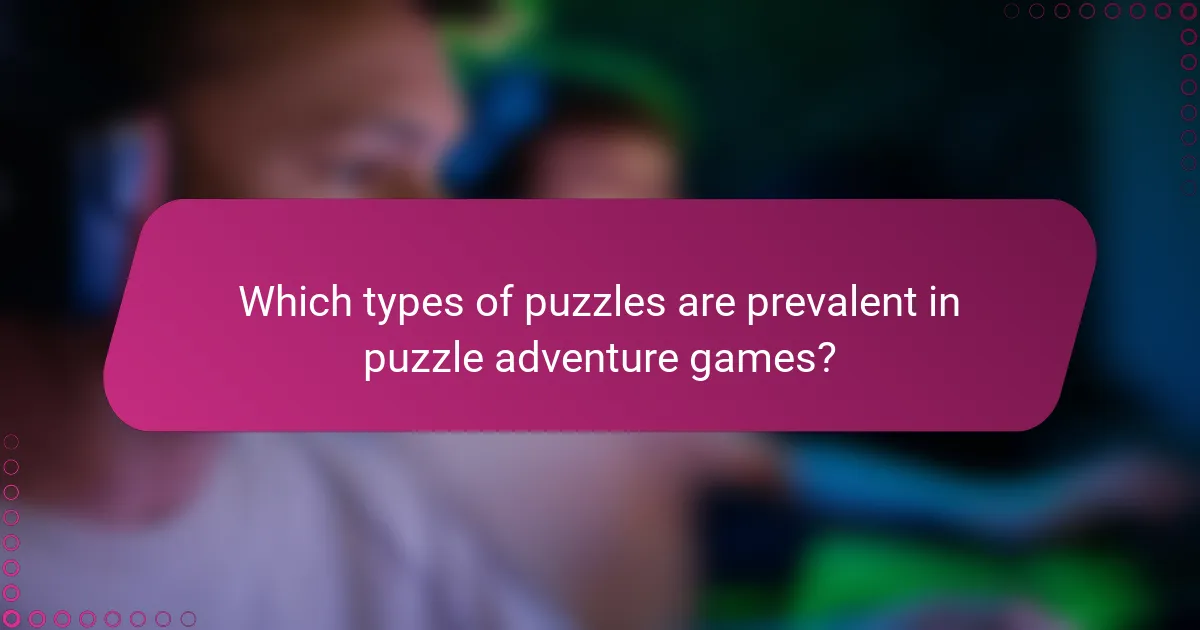
Which types of puzzles are prevalent in puzzle adventure games?
Puzzle adventure games feature various prevalent puzzle types that challenge players’ problem-solving skills. Common types include logic puzzles, riddles, environmental puzzles, pattern recognition challenges, and item combination tasks. Each type requires unique strategies for successful completion, enhancing the overall gaming experience.
How do logic puzzles differ from environmental puzzles?
Logic puzzles focus on deductive reasoning, while environmental puzzles emphasize interaction with surroundings. Logic puzzles often require players to solve problems using clues and logical deduction. In contrast, environmental puzzles require players to manipulate objects and explore their environment to progress. Both types challenge players but do so through different mechanics and thought processes.
What are the characteristics of narrative-driven puzzles?
Narrative-driven puzzles feature immersive storytelling, character development, and context-rich environments. They engage players through plot-driven challenges that require critical thinking and problem-solving skills. These puzzles often intertwine narrative elements with gameplay mechanics, enhancing player experience. Unique attributes include emotional engagement and thematic depth, which differentiate them from traditional puzzle types.
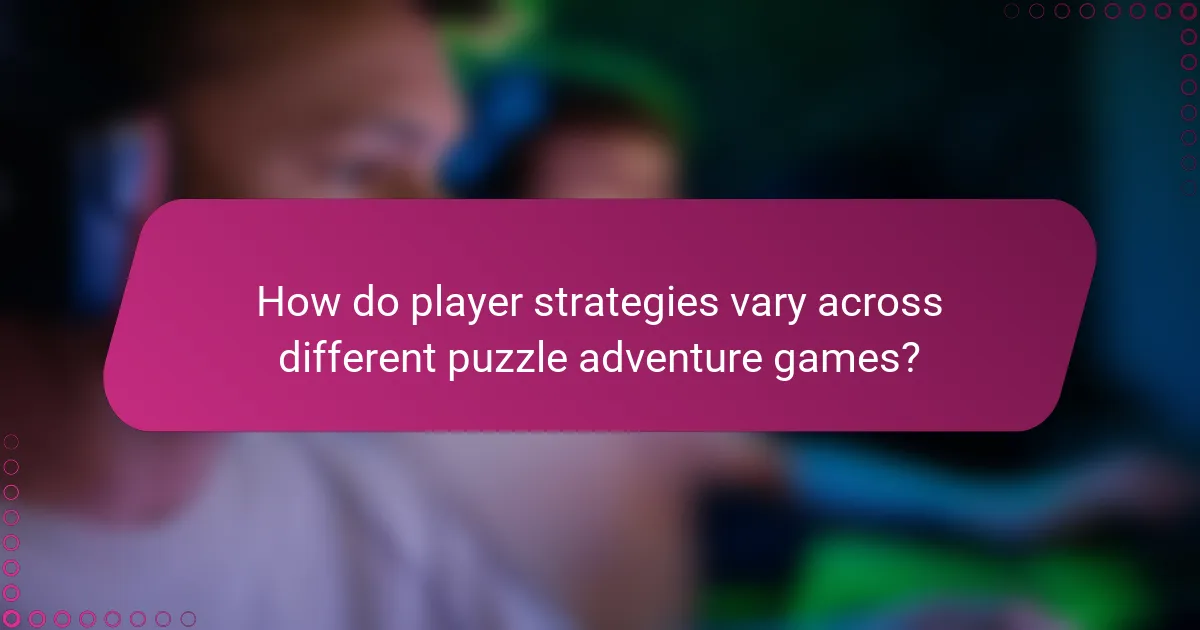
How do player strategies vary across different puzzle adventure games?
Player strategies in puzzle adventure games vary based on game mechanics and puzzle types. Players often adapt their approaches to problem-solving, exploration, and resource management.
In games emphasizing logic puzzles, players may focus on critical thinking and pattern recognition. Conversely, in narrative-driven titles, strategies might involve dialogue choices and environmental exploration.
Some games require collaboration or competition with others, influencing strategy by necessitating teamwork or strategic deception. Unique attributes, such as time limits or limited resources, further shape player tactics, creating diverse gameplay experiences.
Overall, the variety in puzzle types and game mechanics leads to a rich tapestry of player strategies tailored to individual game challenges.
What collaborative strategies do players employ in multiplayer settings?
Players in multiplayer puzzle adventure games employ collaborative strategies like communication, role specialization, and shared problem-solving. Effective communication enhances teamwork, allowing players to discuss strategies and share insights on puzzles. Role specialization involves assigning specific tasks based on individual strengths, such as puzzle-solving or exploration. Shared problem-solving encourages players to combine their skills and perspectives, leading to innovative solutions. These strategies not only enhance gameplay but also foster a sense of community among players.
How do individual play styles influence puzzle-solving approaches?
Individual play styles significantly shape puzzle-solving approaches in puzzle adventure games. Players may adopt methods that align with their preferences, such as analytical reasoning, creative thinking, or trial-and-error.
Analytical players excel in logic-based puzzles, breaking down problems systematically. Creative players often approach challenges with innovative solutions, while those who prefer trial-and-error may experiment until they find a solution.
The variety in play styles leads to diverse strategies, enhancing the overall gaming experience. For example, a player who enjoys exploration may focus on environmental clues, whereas a more strategic player might prioritize inventory management and resource allocation.
Understanding these influences can help game developers design puzzles that cater to different play styles, ensuring a more engaging and satisfying experience for all players.
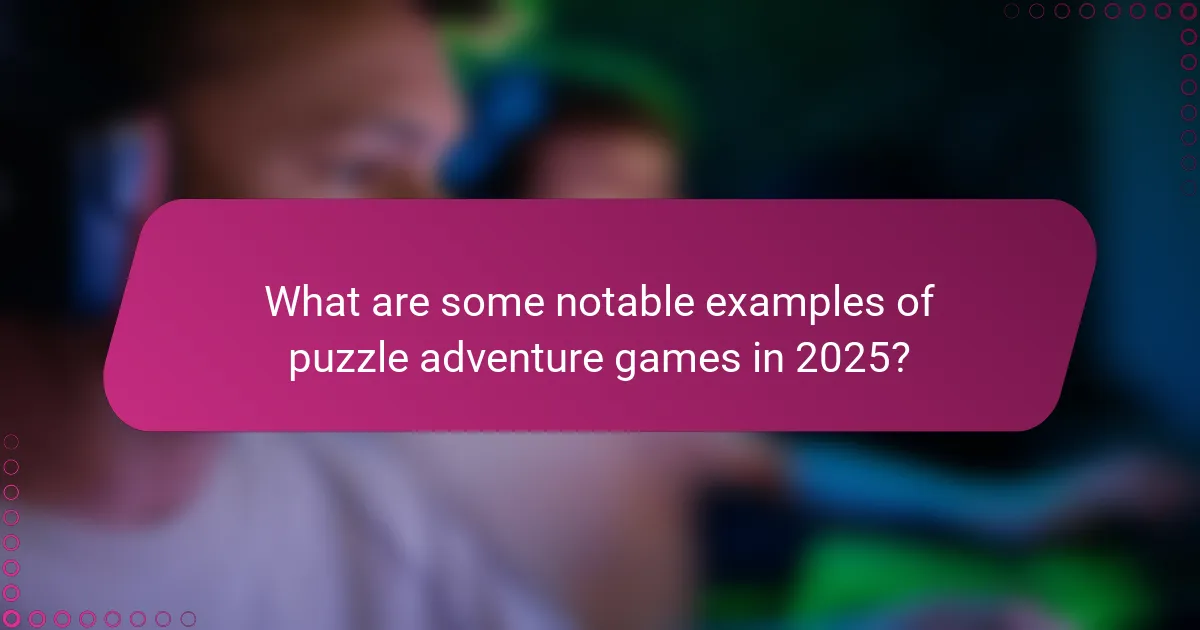
What are some notable examples of puzzle adventure games in 2025?
Notable examples of puzzle adventure games in 2025 include “Mystic Realms,” “Echoes of the Past,” and “Lost in Time.” These games feature unique challenges, diverse puzzle types, and engaging player strategies that enhance the gaming experience. “Mystic Realms” offers immersive environments with intricate lore, while “Echoes of the Past” focuses on time manipulation puzzles. “Lost in Time” combines exploration with narrative-driven challenges, appealing to a wide range of players.
How do these games reflect cultural themes and trends?
Puzzle adventure games often reflect cultural themes and trends through their narratives and gameplay mechanics. These games incorporate local myths, historical events, and social issues, allowing players to engage with diverse cultures. For instance, puzzles may draw from folklore, enhancing players’ understanding of cultural heritage. Additionally, the cooperative gameplay in some titles mirrors contemporary values of teamwork and community, reflecting societal shifts toward collaboration. The unique art styles and music also contribute to a game’s cultural identity, making it a rich medium for exploring and celebrating cultural diversity.
Which titles have set new standards for innovation in the genre?
Recent titles like “The Witness,” “Return of the Obra Dinn,” and “Baba Is You” have set new standards for innovation in puzzle adventure games. These games introduce unique mechanics and challenge players to think creatively. “The Witness” emphasizes environmental storytelling through intricate puzzles. “Return of the Obra Dinn” innovates with a deduction-based approach, requiring players to piece together events. “Baba Is You” revolutionizes puzzle-solving with a mechanic that allows players to manipulate the rules of the game itself. Each title showcases distinctive attributes that enhance player engagement and redefine genre expectations.
What feedback mechanisms do players find most effective in these games?
Players find visual and auditory feedback most effective in puzzle adventure games. Clear cues, such as animations and sound effects, enhance engagement and signal progress. Timely feedback on puzzle completion and hints also improves player satisfaction. Additionally, adaptive feedback based on player performance helps tailor challenges, maintaining motivation.
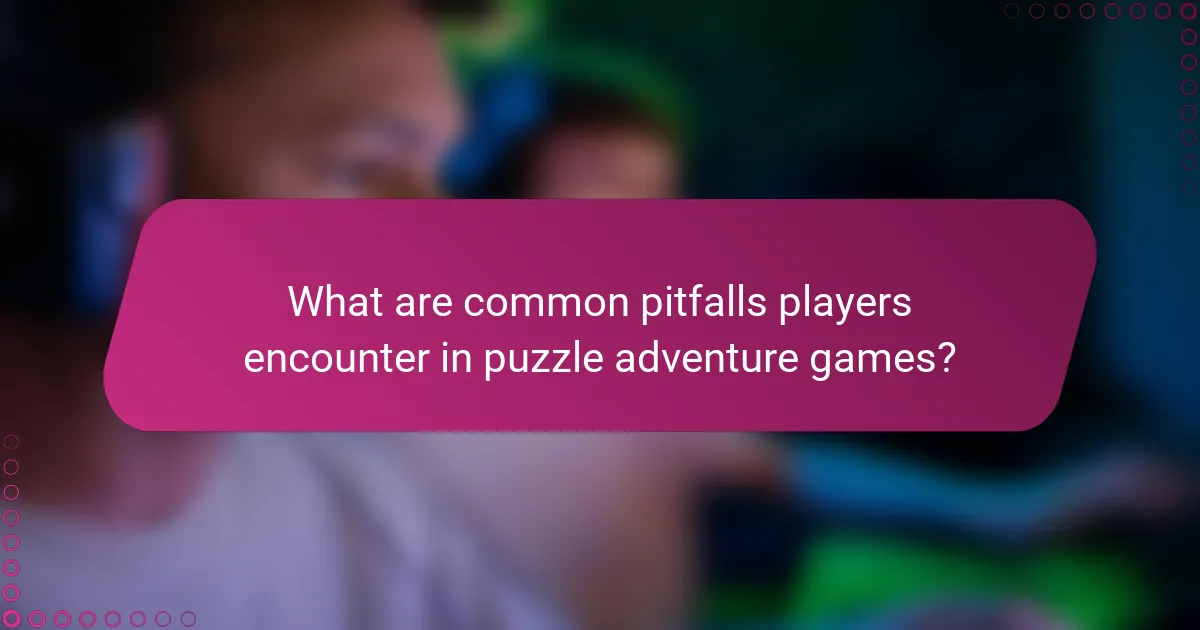
What are common pitfalls players encounter in puzzle adventure games?
Players in puzzle adventure games often encounter pitfalls such as frustration from complex puzzles, difficulty in understanding game mechanics, and a lack of clear guidance. These challenges can lead to disengagement and hinder progress. Additionally, players may struggle with time constraints or miss critical clues, impacting their overall experience. Balancing puzzle difficulty and providing hints can enhance player satisfaction and retention.
How can players avoid frustration during challenging puzzles?
Players can avoid frustration during challenging puzzles by employing effective strategies. First, take breaks to clear your mind and return with fresh perspectives. Second, analyze the puzzle’s components to identify patterns or clues. Third, collaborate with others for insights or different approaches. Fourth, utilize in-game hints sparingly to maintain engagement without reliance. Lastly, practice patience; developing skills over time enhances problem-solving abilities in puzzle adventure games.
What strategies can enhance player engagement and retention?
To enhance player engagement and retention in puzzle adventure games, developers should implement dynamic challenges, diverse puzzle types, and personalized strategies. Engaging storylines and immersive environments keep players invested. Regular updates and new content can sustain interest over time. Social features, such as leaderboards and cooperative puzzles, foster community and competition, encouraging players to return.
What best practices should developers consider for future puzzle adventure games?
Developers should focus on intuitive controls, diverse puzzle types, and engaging narratives for future puzzle adventure games. Prioritizing player feedback enhances gameplay experience. Incorporating unique attributes, such as environmental puzzles, fosters creativity. Balancing difficulty levels ensures accessibility while maintaining challenge. Regular updates and community engagement sustain player interest.


